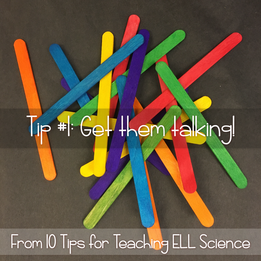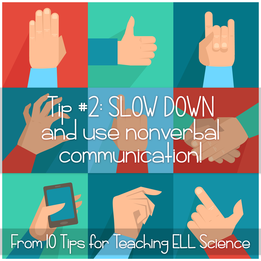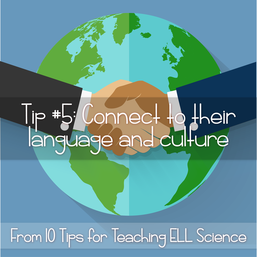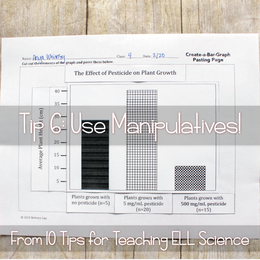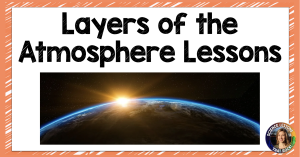If you’ve been teaching for a while, chances are you have had some ELL (English language learner) students in your classroom. I’ve known many teachers that have panicked and asked me “how can I teach them science if they don’t speak English?” I think many teachers tend to think they need to dumb down the content for these students. They aren’t dumb! Your job is to make the content accessible. It’s been my experience that ELL students are amazingly hard workers and are a blast to work with. My friend Bethany Lau over at Science with Mrs. Lau and I have created a list of best-practice tips for working with ELL students. We also have some helpful resources to share with you!
Tip #1: Get them talking! A quiet classroom is not conducive to learning a new language. Many students are scared to speak out loud in English, especially in front of the entire class. To help build their confidence, try small group discussions first. To ensure that every student has spoken to his or her group, give each student something color-coded (I use colored Popsicle sticks from the dollar store). When a student speaks, they place their Popsicle stick in the center of the table. It is easy as a teacher to walk around and monitor who is speaking and who isn’t. Make it a requirement that each student has to speak at least twice during group discussions.
Tip #2: SLOW down when you are talking, and use nonverbal cues. This is much easier to do when you have all your ELL students together in one class, but when they are mixed with native English speakers we often don’t realize how fast we are talking. It is really difficult for ELL students to process when you are speaking a mile a minute. So take a deep breath, slow down, and use your hands and other nonverbal gestures. Don’t be afraid to act things out! Yes they will giggle, and yes they will love it.
Tip #3: Build vocabulary. When you teach new words, always make your students repeat the word out loud after you say it. And if they aren’t loud, make them do it again. If you have a word wall in your classroom, go down the list frequently and make your students say them with you. To help students remember the definitions, discuss prefixes and suffixes to help them decode meanings.
Find fun ways for students to practice those new words. Instead of doing vocabulary worksheets, do vocabulary games instead! Bingo is an awesome way to review vocabulary words before a test. Create a bingo card from a free online bingo-card maker such as http://osric.com/bingo-card-generator/. Type in the words you want your students to learn and print a class set. Instead of calling out the words, say the definition and the students need to cover up the correct word. If they get a bingo they need to say the words out loud in order to win a prize.
Find fun ways for students to practice those new words. Instead of doing vocabulary worksheets, do vocabulary games instead! Bingo is an awesome way to review vocabulary words before a test. Create a bingo card from a free online bingo-card maker such as http://osric.com/bingo-card-generator/. Type in the words you want your students to learn and print a class set. Instead of calling out the words, say the definition and the students need to cover up the correct word. If they get a bingo they need to say the words out loud in order to win a prize.
Tip #4: Utilize pictures. I used to try and translate parts of my power points into Spanish before the lesson thinking I was doing my students a favor. I quickly realized that:
a. Google translate is frequently wrong,
b. many of my students can speak fluent Spanish but can’t read it,
c. and even if they could read most of it, they didn’t know the content specific terms in Spanish. Why would I want my students to learn the word “homeostasis” in Spanish AND English? Let’s just stick with English.
Instead of translating, stick with visual pictures. Pictures transcend all languages. Include them as much as possible in your lessons and power points. Make students draw pictures in their notes. Include pictures in all your articles you want students to read. A great pre-reading activity is to have students look at the pictures and captions in an article before they read the body paragraphs. Have them guess what the article is about based on the pictures and discuss with their neighbors (get those Popsicle sticks back out). If you have a word wall in your classroom, make sure it includes pictures too! The more they see a picture associated with a new word, the more likely they will remember what it means.
a. Google translate is frequently wrong,
b. many of my students can speak fluent Spanish but can’t read it,
c. and even if they could read most of it, they didn’t know the content specific terms in Spanish. Why would I want my students to learn the word “homeostasis” in Spanish AND English? Let’s just stick with English.
Instead of translating, stick with visual pictures. Pictures transcend all languages. Include them as much as possible in your lessons and power points. Make students draw pictures in their notes. Include pictures in all your articles you want students to read. A great pre-reading activity is to have students look at the pictures and captions in an article before they read the body paragraphs. Have them guess what the article is about based on the pictures and discuss with their neighbors (get those Popsicle sticks back out). If you have a word wall in your classroom, make sure it includes pictures too! The more they see a picture associated with a new word, the more likely they will remember what it means.
Tip #5: Learn about their language and culture, and include it in your lessons when applicable. Students will have more buy-in to your lessons when they feel like their language and culture is valued. If you can connect their language to the content, chances are they will remember it better. For example, students use the term “liga” in Spanish to mean rubber band or hair elastic. When teaching “ligaments,” discuss how they are stretchy unlike tendons. Students won’t forget!
Tip #6: Use Manipulatives! Sometimes students need help learning how to structure their writing into logical paragraphs (even native English speakers need this too!) If you have sample paragraphs for them to learn from, you can print separate sentences out on separate lines, and cut them into strips. Then you can mix the sentences up and have students order them in how they should logically appear in a sentence! You can also do this for other parts of a lab report, like the procedure section or even the proper labels for a graph!
You could create your own writing structure manipulatives, or you can check out Bethany Lau’s Lab Report Writing Activity Bundle found here. She has a set of activities with manipulative for each and every part of the lab report with a lot of examples for students to learn from.
You could create your own writing structure manipulatives, or you can check out Bethany Lau’s Lab Report Writing Activity Bundle found here. She has a set of activities with manipulative for each and every part of the lab report with a lot of examples for students to learn from.
Tip #7: Get them writing as much as possible. Data shows that when students take the state language proficiency tests, they struggle the most with writing. Find ways to get students writing on a daily basis. This could work in many different formats- just find one that works for you. Daily bellwork is a great place to start, as well as having students keep writing journals. What should you have them write about? Check out these writing prompts from Science Rocks’ store! These were designed to be used before new concepts are taught, and allows the teacher to assess prior knowledge and check for misconceptions. When students are first learning English, allow them to write in their native language and plug in English words that they know. Throughout the year as their language improves you will see their writing transform from fragmented to fluid sentences.
Another great writing strategy for ELL students are sentence frames. For students still learning how to write a complete sentence, give them half the sentence first and have them fill in the blanks. For example, a hypothesis on a lab report for an ELL student could look like this: “If I change ___________, then I think ___________ will happen, because __________.”
Another great writing strategy for ELL students are sentence frames. For students still learning how to write a complete sentence, give them half the sentence first and have them fill in the blanks. For example, a hypothesis on a lab report for an ELL student could look like this: “If I change ___________, then I think ___________ will happen, because __________.”
Tip #8: Model. And then model some more. As science teachers we tend to think of “modeling” as meaning “I’ll show them how to do a lab before it’s their turn.” Modeling applies to so much more than labs.
a. Model reading strategies. As you read through articles out loud, stop and discuss. What was the main idea? What did you highlight and why?
b. Model writing strategies. When you assign those writing prompts, work through one with them first. Show them what a quality answer would look like.
c. Model behaviors. Many students will enter your classroom from different backgrounds. Behaviors that may have been acceptable where they grew up may not be acceptable in your classroom. If you want them to give a verbal presentation with eye contact, show them what a good presentation looks like first.
d. Model word pronunciation. Sometimes if students are nervous to say things in English, I have them teach me how to say the phrase in their native language first. Once they have giggled at my horrible pronunciation, they aren’t so embarrassed to pronounce things in English.
a. Model reading strategies. As you read through articles out loud, stop and discuss. What was the main idea? What did you highlight and why?
b. Model writing strategies. When you assign those writing prompts, work through one with them first. Show them what a quality answer would look like.
c. Model behaviors. Many students will enter your classroom from different backgrounds. Behaviors that may have been acceptable where they grew up may not be acceptable in your classroom. If you want them to give a verbal presentation with eye contact, show them what a good presentation looks like first.
d. Model word pronunciation. Sometimes if students are nervous to say things in English, I have them teach me how to say the phrase in their native language first. Once they have giggled at my horrible pronunciation, they aren’t so embarrassed to pronounce things in English.
Tip #9: Modify. Yes, one more thing to add to your to-do list. But it can honestly be as simple as cutting down the number of questions for them to complete, or adding pictures to an assessment. One of my favorite websites to find nonfiction science articles on is newsela.com. Not only is it free to use, but once you find an article you can change the lexile! That means all your students can be reading the same article but at a reading level that is accessible to them.
Tip #10: Use formative assessment frequently, and celebrate gains. It’s important to check in with ELL students often. Many of them will take notes, smile, and nod during class, but only understood 20% of what was discussed. Exit tickets and note summaries are great ways to check in and see where they need help and what they have mastered. Make your exit tickets specific. Don’t just say, “One thing I still need help with is…” but instead ask them to answer a specific question related to the lesson. This will help you group them by mastery and focus on the students that really need your help. Once they have mastered a new concept or learned new vocabulary, don’t forget to celebrate! Let them know you are proud of them, and they will work harder in the future. If students feel like their hard work is recognized and celebrated, they will continue to work hard!
We’d love to hear stories from you about what helps your ELL students! Let us know in the comments!
Want to save this blog post for later? Click here to repin!


